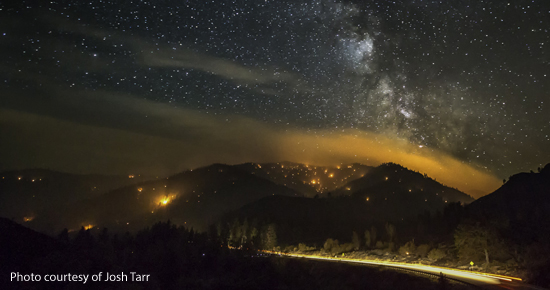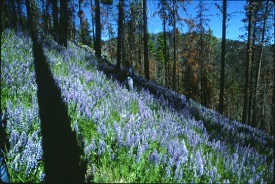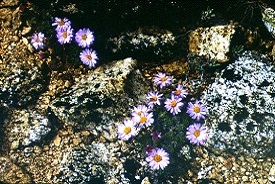|
Carlton Complex Wildfire Recovery

The lives of many of our Methow Valley neighbors and friends were seriously disrupted, and some changed forever by the loss of a home, as wildfires burned throughout the area during the past three weeks. Although the sight of the scorched earth can be depressing, we want to encourage community members not to despair! While the magnitude of this tragic event is hard to fathom from a human perspective, we are already witnessing amazing community strength and resiliency, and we know that with help those affected will recover. PBI intends to continue to assist our community in this effort. We also anticipate the rapid ecological recovery of the area, and will document the changes and impacts to the shrub-steppe and ponderosa pine ecosystems and wildlife, over the months and years ahead.
As background for those who may not have followed this news as closely as local residents, the Carlton Wildfire Complex is composed of four wildfires that eventually merged to form what is now the largest fire in Washington State's recorded history. The fires were ignited from a lightning storm on July 14, with an additional 502 acres burned in the Rising Eagle Road fire of August 1. The total current fire area as of August 8 is estimated to be over 256,000 acres. Two new wildfires started on Aug. 2 and have grown very large, threatening several parts of the upper Methow Valley. The fire situation here is far from resolved.
PBI responded to a request by a local, grass roots organization – the Carlton Complex Fire Recovery and Assistance Network – to provide their volunteers with a set of detailed maps of the properties that were impacted by the fires. In addition, we produced a list of affected property owners, organized by each major watershed within the fire area. This information was also requested by, and provided to, the Red Cross.
From our analysis of the initial fire area, we learned that over 4,240 private parcels were within the fire perimeter, comprising over 41% of the burn area. Not all these parcels burned in the fire, but most did, with over 300 homes destroyed and significant losses of livestock and agricultural crops. Overall, the impacts to the local community have been very significant.
The Carlton Complex fires burned largely through shrub-steppe habitat, grasslands and other non-forested land cover types. We analyzed three land cover, land use and vegetation datasets. From our analysis of this data, it is apparent that the vast majority of the area burned in the Carlton Complex was non-forested land cover types and only about 25% was forested. Nearly all the forests that burned are ponderosa pine or ponderosa pine / Douglas-fir forests – often characterized as “dry forests.”
The dominant vegetation types in the fire area (shrub-steppe and dry forests) are considered fire-adapted and fire-dependent ecosystems from an ecological perspective. These ecosystems need regular fire to maintain healthy composition and structure. The lack of fire has been documented to be a major cause of declining health of these ecosystems. The natural areas that burned in the fire may well experience a significant long-term benefit from the fire. The photos below document the rapid recovery from other recent fires that have burned in this area.
 
PBI researchers studied ecosystem recovery after several nearby wildfires during the last two decades. Reviewing data and photographs from the three wildfires gives us insight into how nature will respond to the current wildfires. Two months after the Thirtymile Fire (2001) in the upper Chewuch River Watershed, cottonwoods and aspens were already 3 to 6 feet tall in an area that burned black with complete tree mortality. Bitterbrush was resprouting a month after the Libby South Fire (2001) and there was vibrant regrowth of grasses and wildflowers the next spring. The spring after the Tyee Fire Complex (1994) in the Entiat River watershed, as shown in the photos above, there was vibrant recovery of shrub-steppe habitat and understory vegetation in the ponderosa pine forests. The area had been blackened by the fire and understory and shrub-steppe vegetation had been consumed. Again, we must not despair! Nature has enormous power to recover from these wildfires. In a few years, the Methow Valley will regain its renowned beauty.
Lucila Castro, PBI Biologist, Presents at a Conference in China
Lucila Castro, PBI’s conservation biologist based in Córdoba, Argentina, recently participated in the 12th International Conference on Salt Lake Research in Beijing, China. The International Society on Salt Lake Research (ISSLR) organizes this event every 3 years, bringing together scientists from around the world from diverse disciplines. Lucila received a scholarship to attend the conference and financial support from her home town, Miramar, Argentina.
Lucila gave a presentation about flamingos and Mar Chiquita (Córdoba Province, Argentina), including some of the results obtained in her degree thesis. The audience responded enthusiastically to her presentation.
Near the end of the conference, she was selected to join the board of the ISSLR. Also, in the closing ceremony of the conference, Lucila was awarded for her excellent presentation with a very important prize given by the Journal of Biological Research - Thessaloniki. The president of the ISSLR presented her with a certificate and a financial award. We are very proud of Lucila's achievements!
|